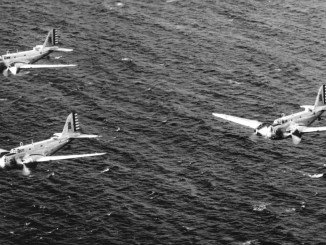
A legendary aircraft of World War II, the Fairey Swordfish wrote itself into history by sinking three Italian battleships in an attack on Taranto and playing a significant role in the sinking of the German battleship Bismarck. Originally entering service in 1936, the ‘Stringbag’ served with distinction until VE-Day and was the most successful Allied torpedo bomber in terms of tonnage of enemy shipping sunk. The original specification was issued in 1933, which added a torpedo carrying requirement to an existing spotter-reconnaissance requirement. Fairey’s prototype first flew in 1934, with orders placed by the Fleet Air Arm the following year.
As was standard for the age, the Swordfish fuselage was constructed from tubular steel with a fabric covering. The large wings were likewise fabric covered, and they could be folded back to save space on carrier decks. The crew of three were housed in an open cabin, exposed to the elements. Although not a powerful or fast aircraft, the Swordfish was a stable platform and proved an excellent delivery vehicle for the Royal Navy’s 18-in aerial torpedoes.
Entering service in 1936, the Swordfish soon replaced existing reconnaissance and bomber aircraft. It was the main carrier bomber of the Fleet Air Arm when the war began, serving alongside an odd collection of combined fighter/dive bomber aircraft. Some Swordfish were modified by the swapping of the wheeled landing gear for floats, allowing the aircraft to operate from battleships and cruisers – as it did with some distinction during the battle for Norway.
In the Pacific and Indian oceans, the Swordfish was less successful. A handful saw service during the battle for Singapore, where they were used mainly for artillery spotting and harassing night bombs of Japanese positions, before being withdrawn prior to the fall of the city. Several carrier and land-based Swordfish were shot down when the Japanese launched their Indian Ocean raid, which included attacks on Royal Navy bases on Ceylon. Through to the end of the war the Swordfish continued to serve as a dependable anti-submarine aircraft.
Fairey Swordfish Specifications
| Fairey Mk I Swordfish | |
| Role | Torpedo bomber |
| Crew | 3 |
| Powerplant | 1x Bristol Pegasus III (690hp) |
| Speed | 143mph (max) |
| Ceiling | 16,500ft |
| Range | 522 miles (internal) |
| Armament | 2x Vickers K |
| Ordnance | 1,500lb bombs 1 torpedoes |
| Dimensions | 35ft 8in (length) 45ft 6in (wingspan) 12ft 4in (height) |
| Wing Area | 607 sq.ft. |
| Weight | 4,195lb (empty) 7,580lb (gross) |
| Number produced | 992 |
| Fairey Mk III Swordfish | |
| Role | Torpedo bomber |
| Crew | |
| Powerplant | 1x Bristol Pegasus 30 (775hp) |
| Speed | |
| Ceiling | 0ft |
| Range | |
| Armament | |
| Ordnance | |
| Dimensions | 0ft 0in (length) 0ft 0in (wingspan) 0ft 0in (height) |
| Weight | |
| Radar | ASV Mk XI () |
| Number produced | 320 |




Leave a Reply